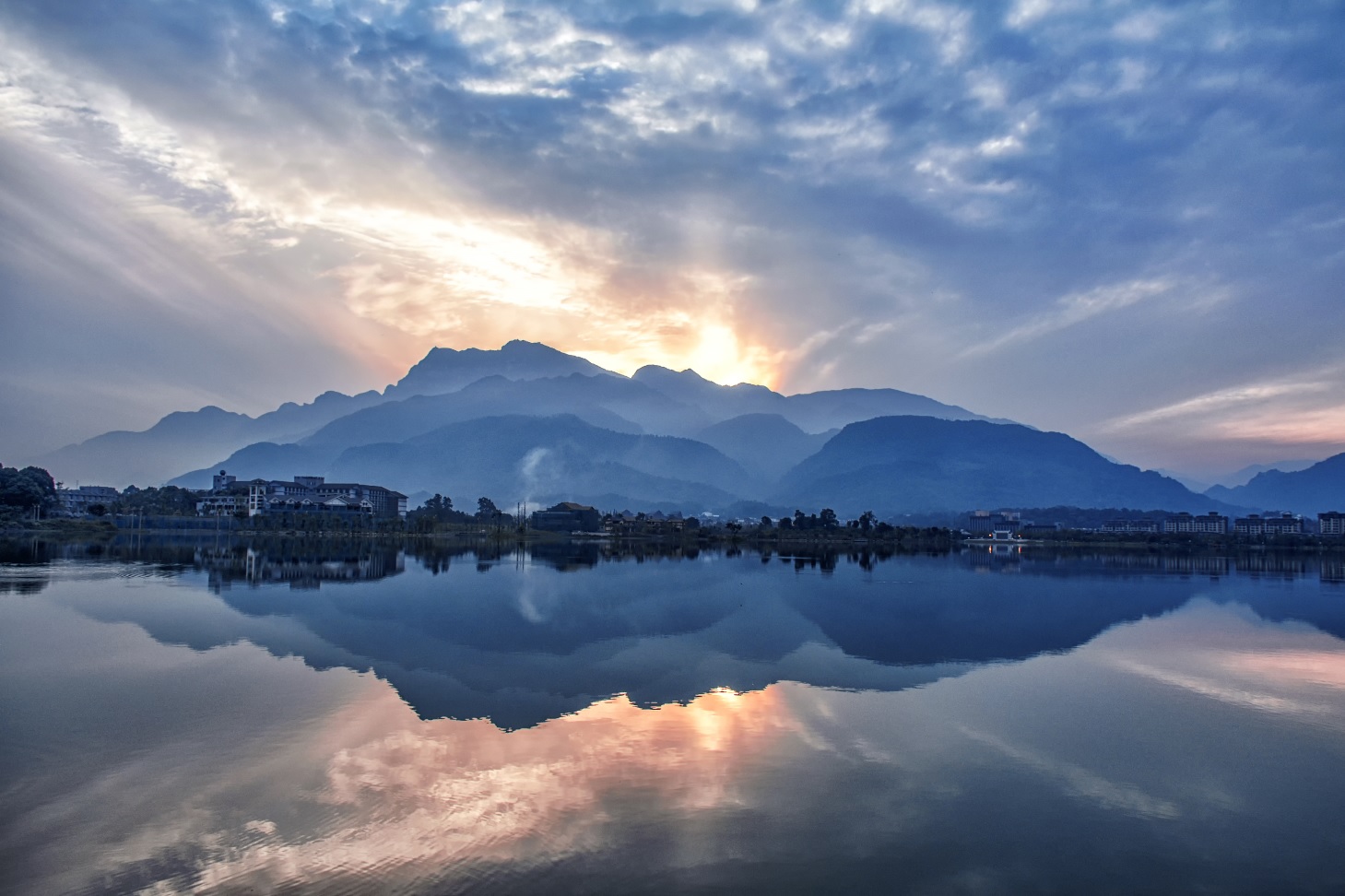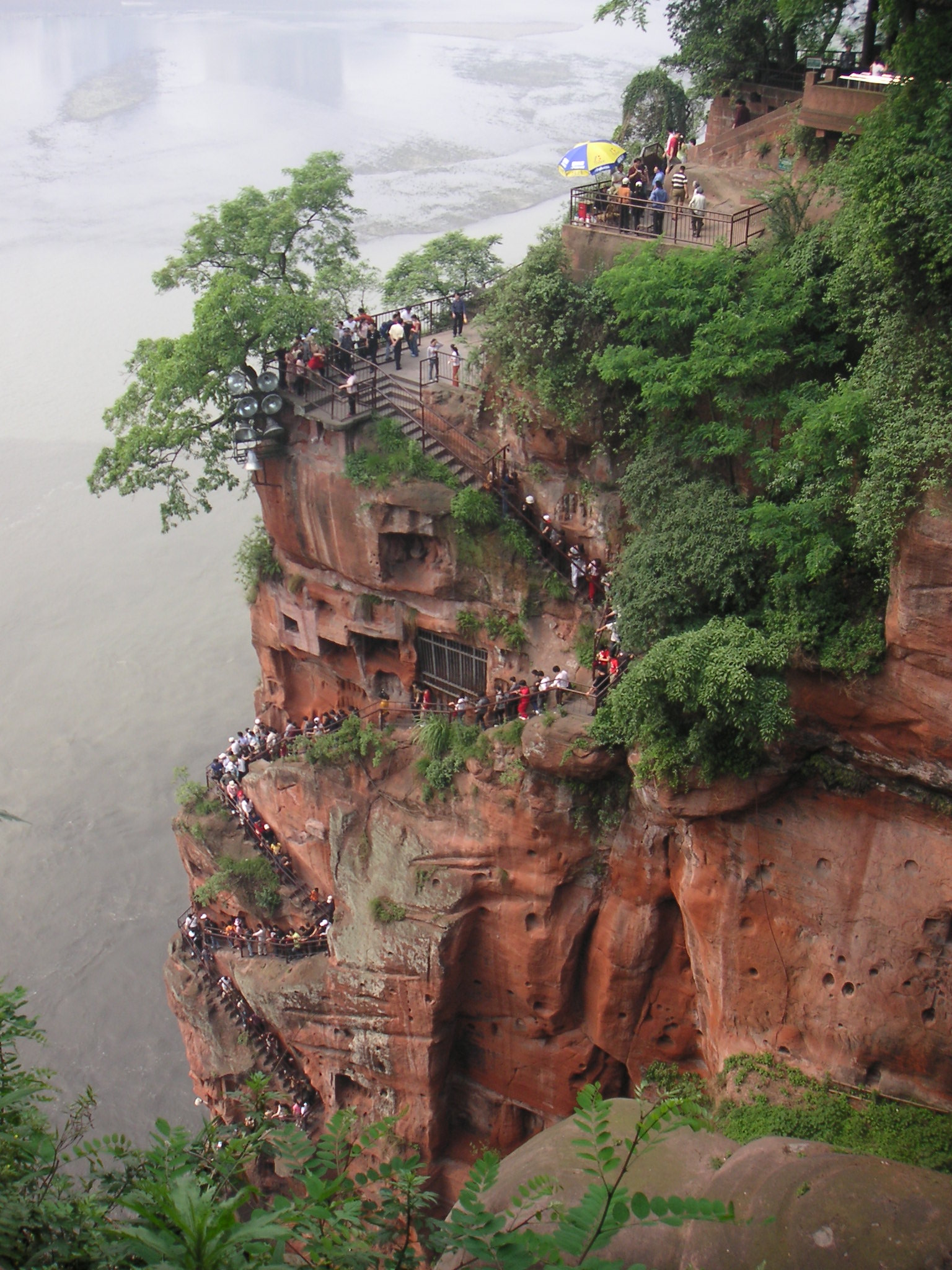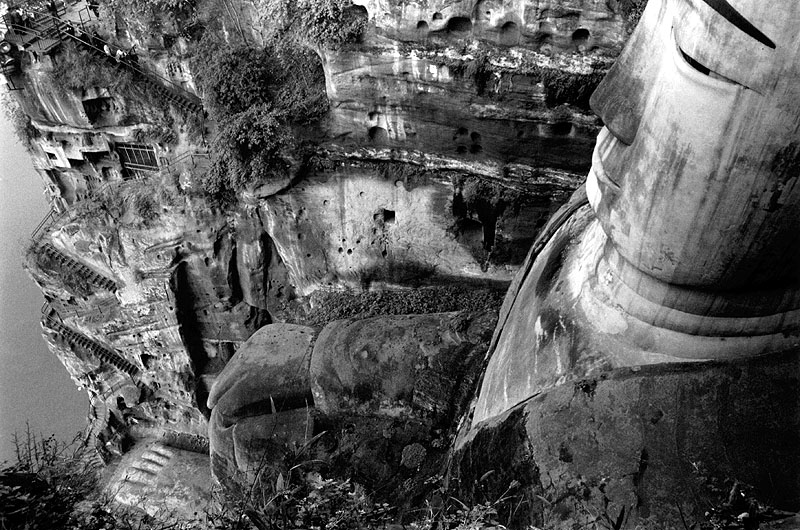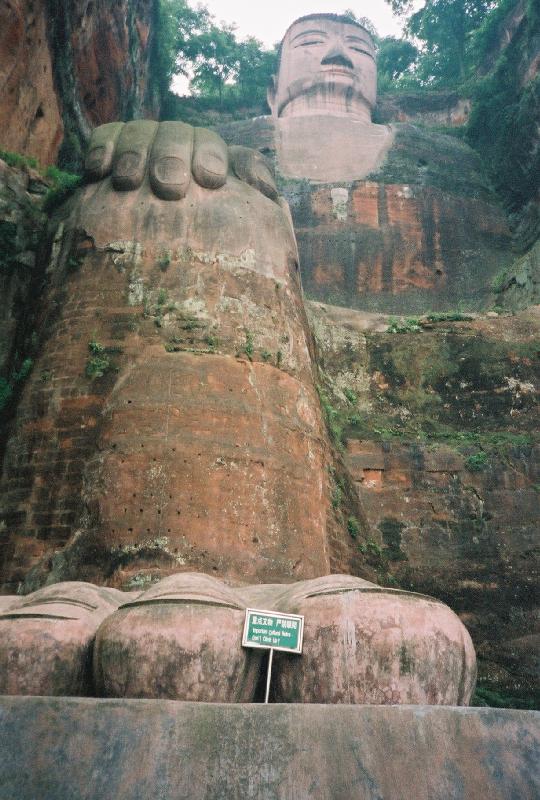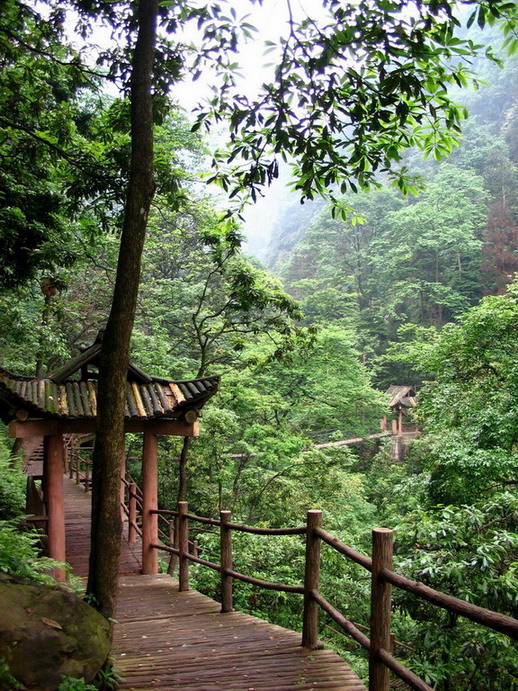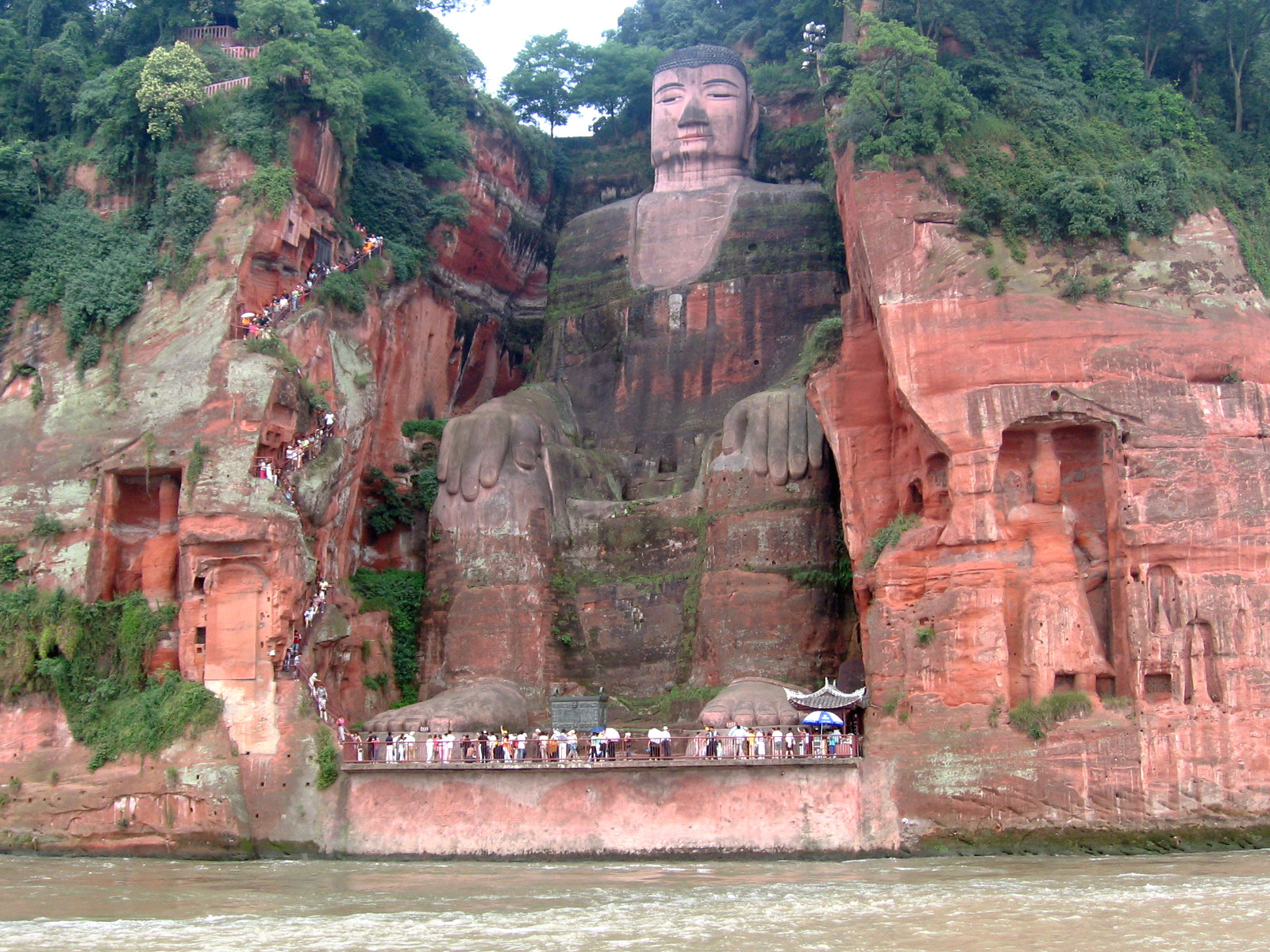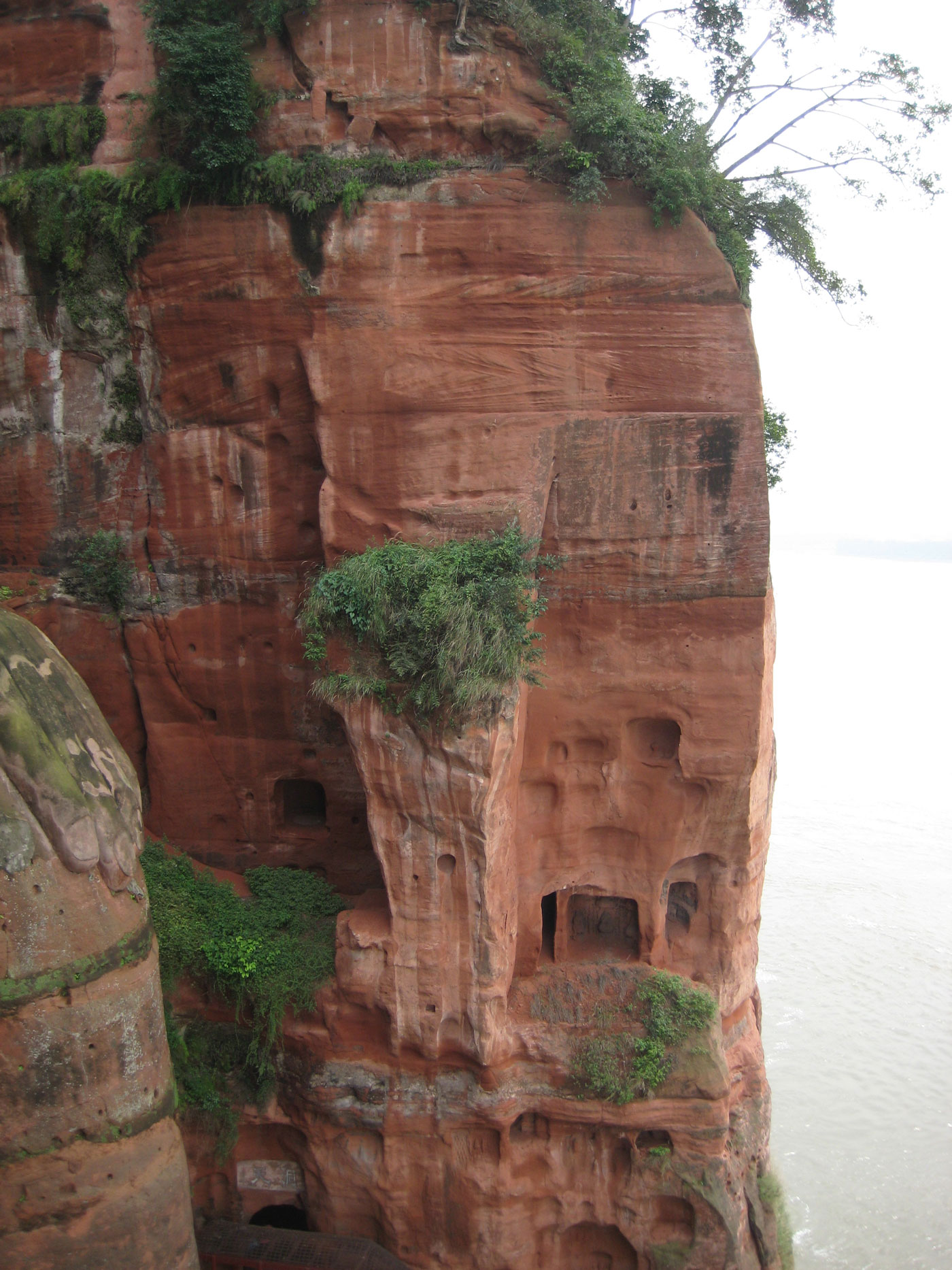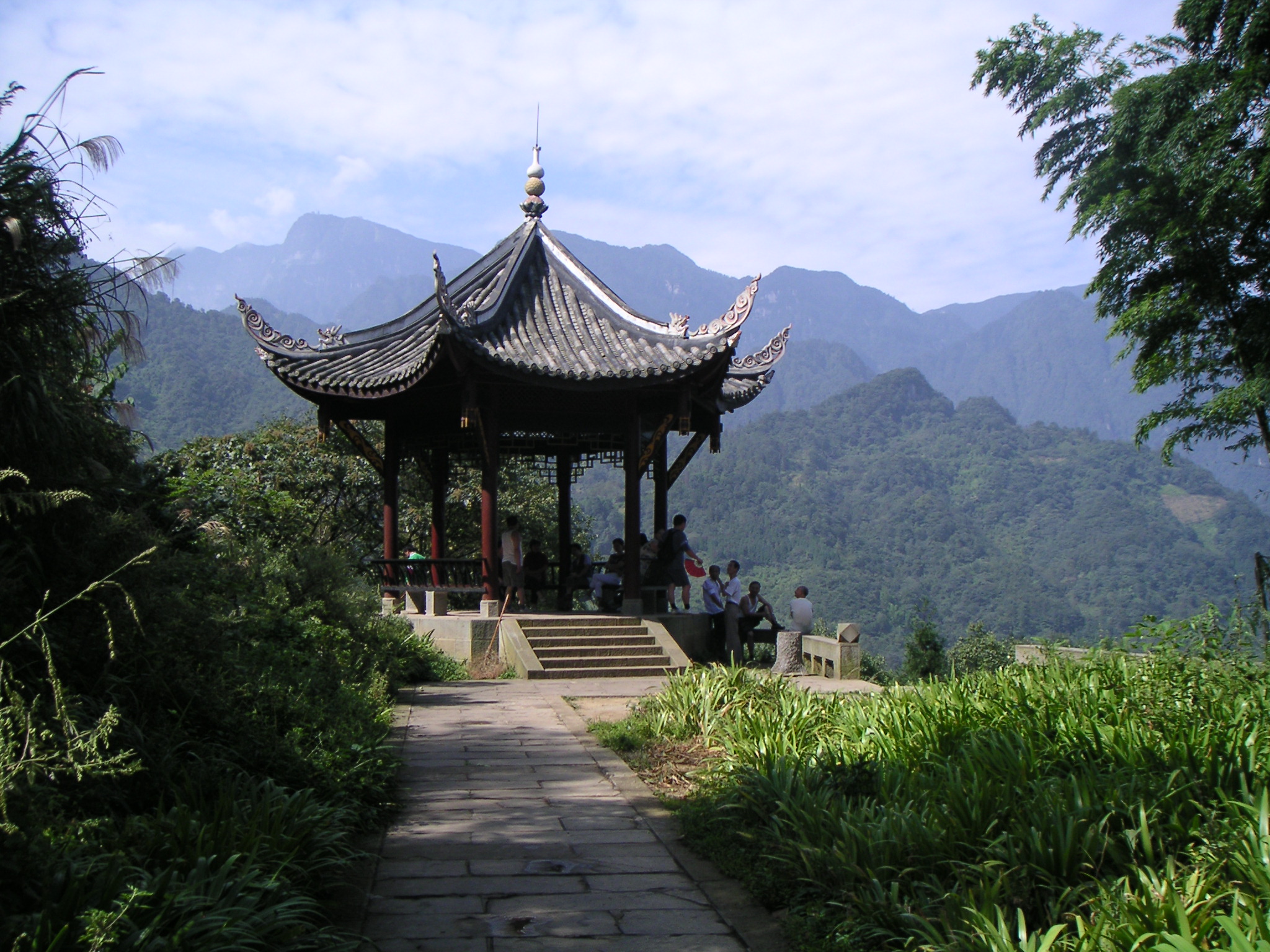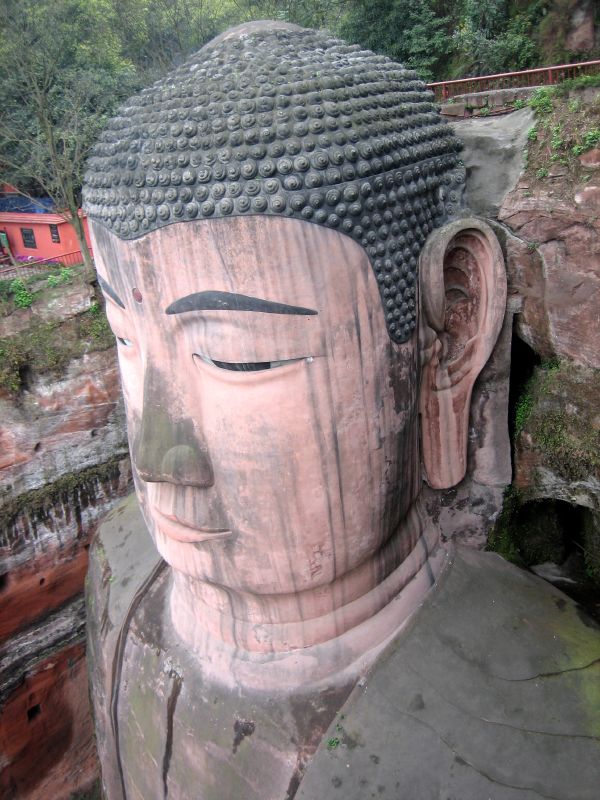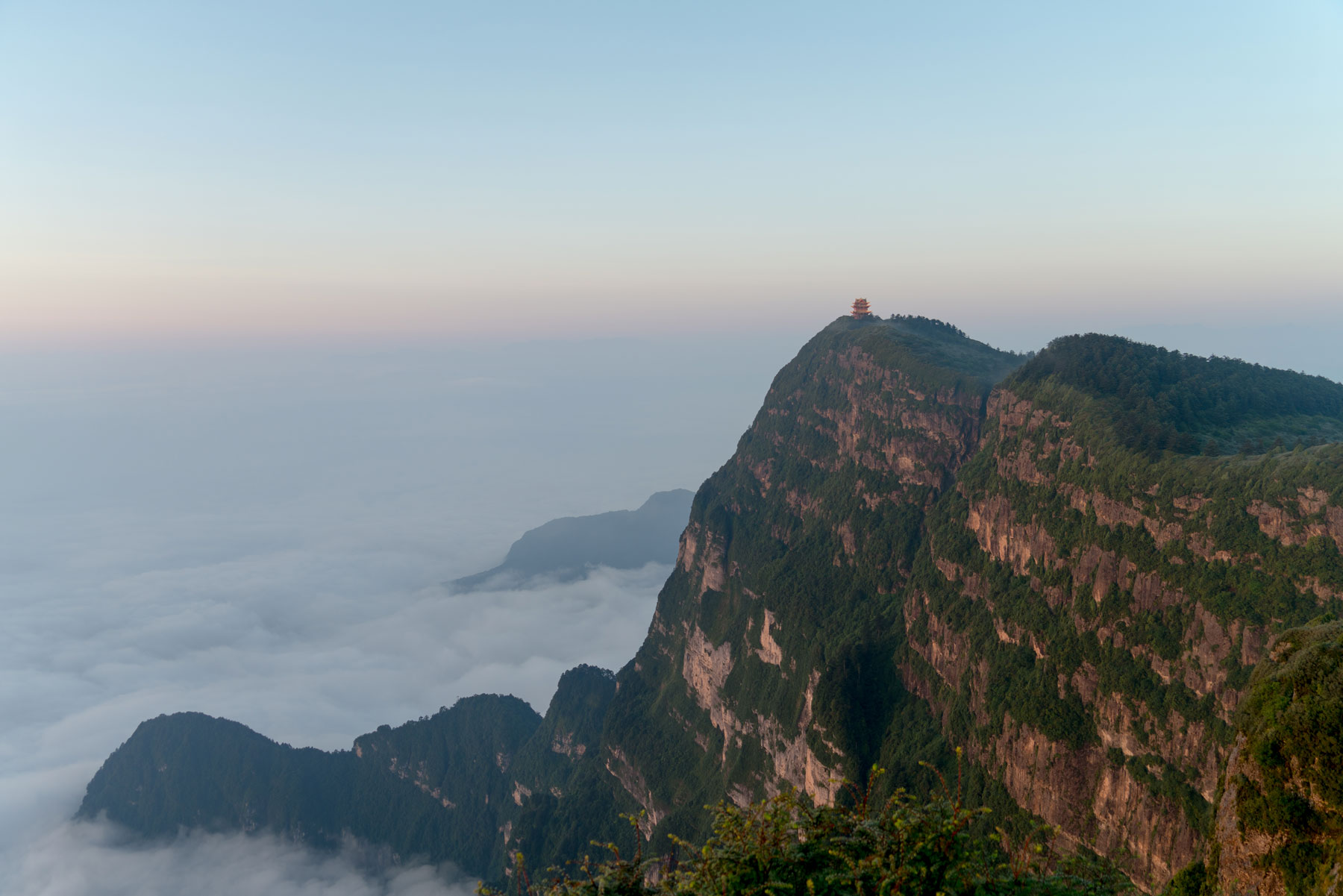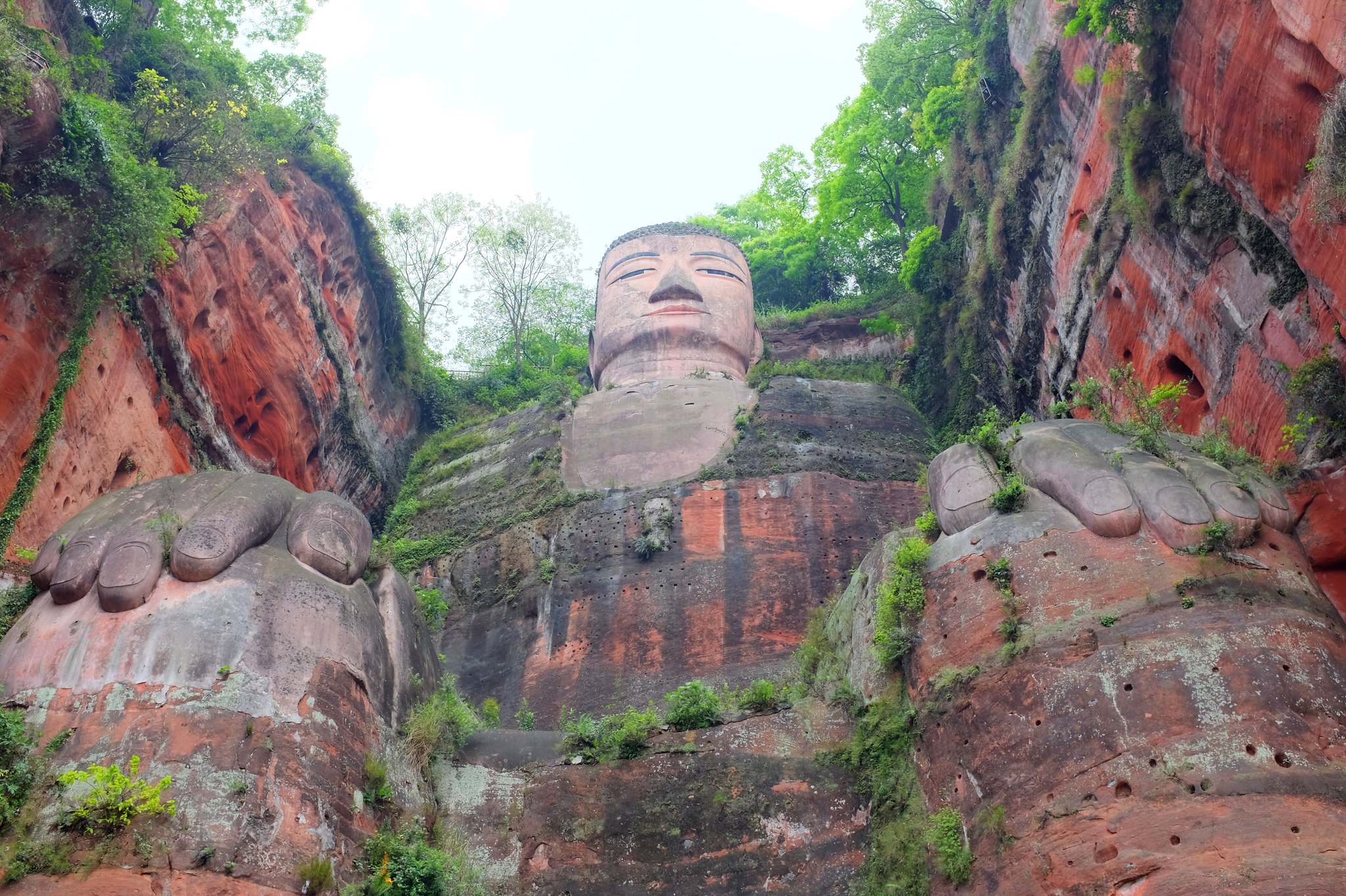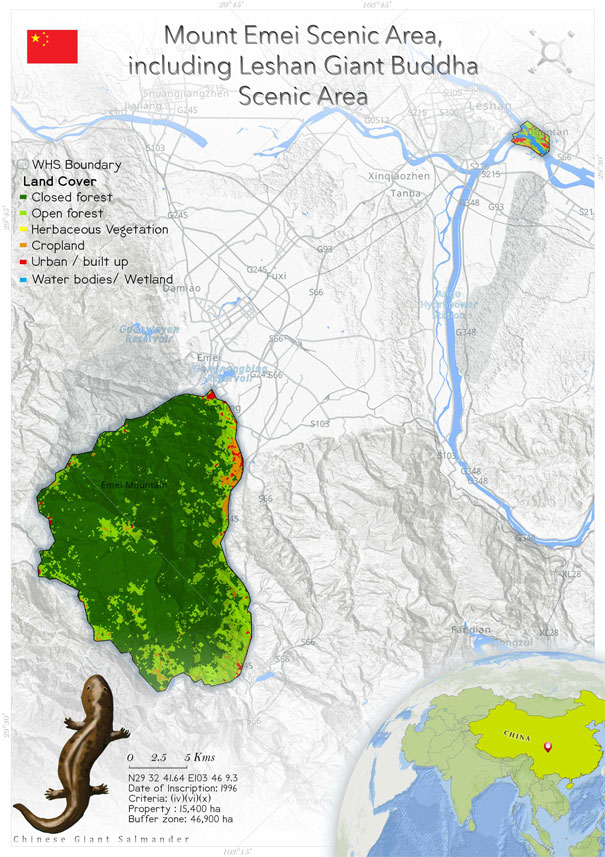
Mount Emei Scenic Area, including Leshan Giant Buddha Scenic Area (779)
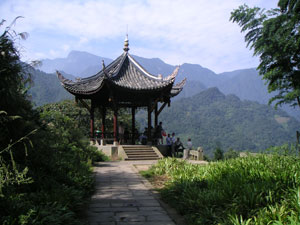 Mount Emei, with an extent of 15,400 ha, consists of two distinct areas, the Mount Emei Scenic Area and the Leshan Giant Buddha Scenic Area. The property is regarded as an area of natural beauty with which the human element has been integrated. The site is situated in the middle of the Sichuan Basin and the Eastern Himalayan mountains. It is blessed with a rich floral diversity that includes 3200 plant species, of which more than 100 are endemic. The sub-tropical plant species found at the site that are classified as threatened in the IUCN Red List include Alsophila, Cibotium barometz and other ombrophyte species. Plants such as Davidia involucrata, Cercidiphyllum and Tetracentron sinense are preserved in the deciduous mixed and evergreen forests of the site. The site is also home to 2300 faunal species such as the red panda, Asiatic black bear, golden cat, Tibetan macaque and Chinese giant salamander. The distinctive features of Mount Emei are intricately linked with the scenic beauty of the site, which is imbued with spiritual and cultural importance. It connects monuments of traditional architecture with the natural environment of this mixed heritage site. The main threats to Mount Emei are tourism, cable cars, construction activities, pollution, flooding, the legal framework and the enforcement measures in place. There is a persistent data gap that has affected monitoring and is not being fully addressed.
Mount Emei, with an extent of 15,400 ha, consists of two distinct areas, the Mount Emei Scenic Area and the Leshan Giant Buddha Scenic Area. The property is regarded as an area of natural beauty with which the human element has been integrated. The site is situated in the middle of the Sichuan Basin and the Eastern Himalayan mountains. It is blessed with a rich floral diversity that includes 3200 plant species, of which more than 100 are endemic. The sub-tropical plant species found at the site that are classified as threatened in the IUCN Red List include Alsophila, Cibotium barometz and other ombrophyte species. Plants such as Davidia involucrata, Cercidiphyllum and Tetracentron sinense are preserved in the deciduous mixed and evergreen forests of the site. The site is also home to 2300 faunal species such as the red panda, Asiatic black bear, golden cat, Tibetan macaque and Chinese giant salamander. The distinctive features of Mount Emei are intricately linked with the scenic beauty of the site, which is imbued with spiritual and cultural importance. It connects monuments of traditional architecture with the natural environment of this mixed heritage site. The main threats to Mount Emei are tourism, cable cars, construction activities, pollution, flooding, the legal framework and the enforcement measures in place. There is a persistent data gap that has affected monitoring and is not being fully addressed.
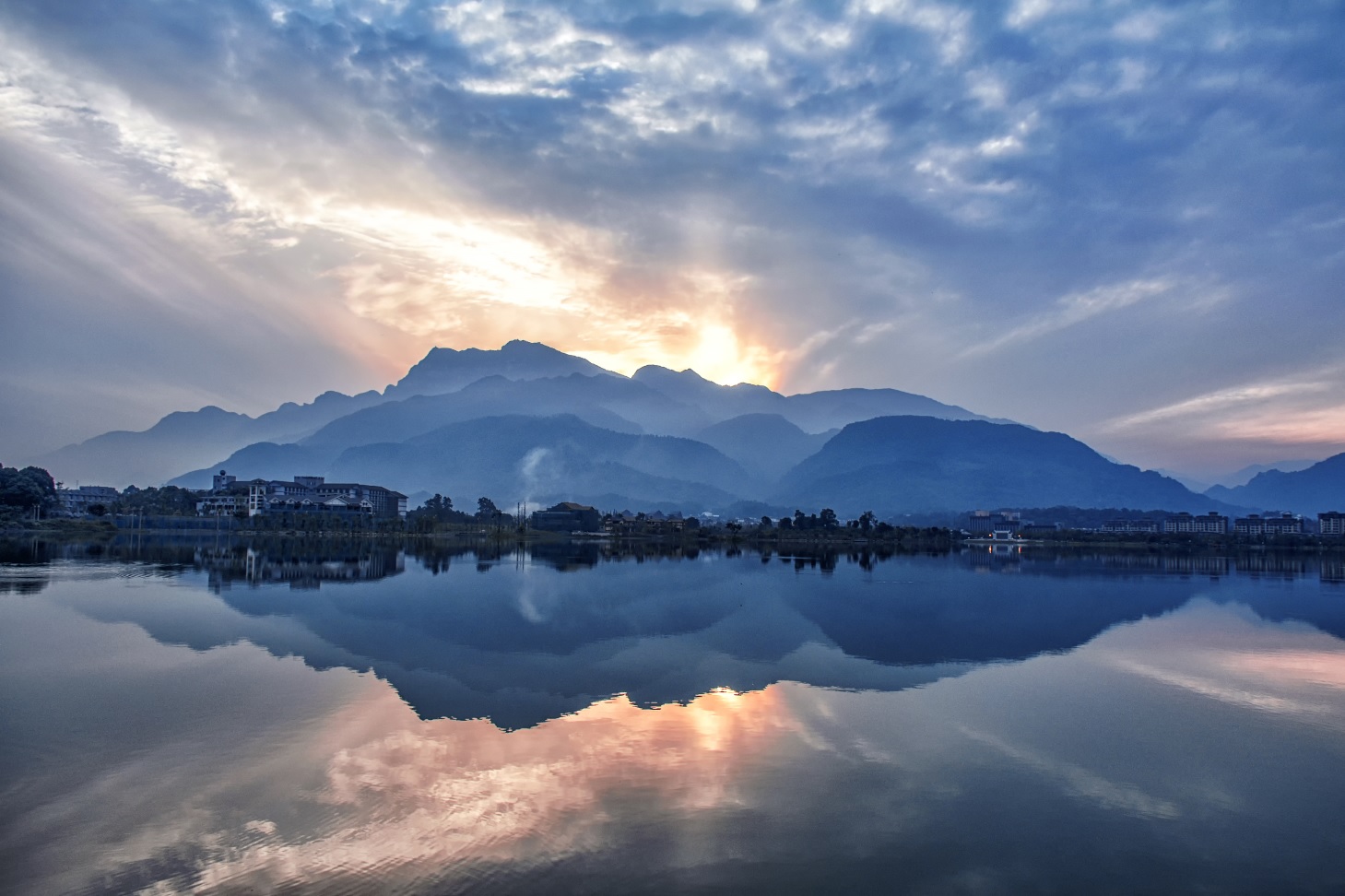 Mount Emeim is categorized as a mixed heritage site with cultural and natural values. It is acclaimed for the institution of Buddhism on Chinese territory, from where it expanded towards the East. The extended area of 15,400 ha is divided into two distinct areas: the Mount Emei Scenic Area and the Leshan Giant Buddha Scenic Area. The plants include orchids, primulas, rhododendrons, camellias, ginkgos, cycads and trees (Foster et al. 2010; Li & Shi 2007). The vegetation is well preserved and forms a vertical band from low to high, culminating in the sub-tropical mountain vegetation landscape. At 2600 m, there are distinct, intersecting, vegetation zones: broad-leaved forest, mixed broadleaved and conifer forest and sub-alpine conifer forest. Sub-tropical plants classified as and threatened in the IUCN Red List include Alsophila, Cibotium barometz and other ombrophyte species. Plants such as Davidia involucrata, Cercidiphyllum and Tetracentron sinense are found in the deciduous mixed and evergreen forests (World Heritage Committee 2012; IUCN Consultation 2017). The site also has 2300 faunal species such as the red panda, Asiatic black bear, golden cat, Tibetan macaque and Chinese giant salamander (State Party of the People’s Republic of China 1995; World Heritage Committee 2012; UNEP-WCMC 2011). Mount Emei is in the WWF Global 200 Freshwater Eco-region list, and it is a Birdlife International Endemic Bird Area. It has been catalogued as a Key Biodiversity Area by Conservation International and as a key site by Alliance for Zero Extinction. It is well protected because of the national sacred sites to be found in it. The first Buddhist temple was constructed in the first century. Popularly known as Guangxiang Temple, in 1614 it got its name of Huazang. Thirty temples were built subsequently, and thus the site is considered one of the holiest sites. Mount Emei is known for its varied vegetation, from sub-tropical to sub-alpine pine forests. Some of the trees are more than 1000 years old. The hillside of Xijuo Peak overlooks the confluence of three rivers and globally significant Buddhist sculptures. There is a set of 500 Han Dynasty tombs from the 1st century to the 4th century on Mohao Crag that are noted for their delicate carvings and calligraphic inscriptions. The distinctive features of Mount Emei are intricately linked with the scenic beauty of the site that reverses extensive spirituality and cultural importance.
Mount Emeim is categorized as a mixed heritage site with cultural and natural values. It is acclaimed for the institution of Buddhism on Chinese territory, from where it expanded towards the East. The extended area of 15,400 ha is divided into two distinct areas: the Mount Emei Scenic Area and the Leshan Giant Buddha Scenic Area. The plants include orchids, primulas, rhododendrons, camellias, ginkgos, cycads and trees (Foster et al. 2010; Li & Shi 2007). The vegetation is well preserved and forms a vertical band from low to high, culminating in the sub-tropical mountain vegetation landscape. At 2600 m, there are distinct, intersecting, vegetation zones: broad-leaved forest, mixed broadleaved and conifer forest and sub-alpine conifer forest. Sub-tropical plants classified as and threatened in the IUCN Red List include Alsophila, Cibotium barometz and other ombrophyte species. Plants such as Davidia involucrata, Cercidiphyllum and Tetracentron sinense are found in the deciduous mixed and evergreen forests (World Heritage Committee 2012; IUCN Consultation 2017). The site also has 2300 faunal species such as the red panda, Asiatic black bear, golden cat, Tibetan macaque and Chinese giant salamander (State Party of the People’s Republic of China 1995; World Heritage Committee 2012; UNEP-WCMC 2011). Mount Emei is in the WWF Global 200 Freshwater Eco-region list, and it is a Birdlife International Endemic Bird Area. It has been catalogued as a Key Biodiversity Area by Conservation International and as a key site by Alliance for Zero Extinction. It is well protected because of the national sacred sites to be found in it. The first Buddhist temple was constructed in the first century. Popularly known as Guangxiang Temple, in 1614 it got its name of Huazang. Thirty temples were built subsequently, and thus the site is considered one of the holiest sites. Mount Emei is known for its varied vegetation, from sub-tropical to sub-alpine pine forests. Some of the trees are more than 1000 years old. The hillside of Xijuo Peak overlooks the confluence of three rivers and globally significant Buddhist sculptures. There is a set of 500 Han Dynasty tombs from the 1st century to the 4th century on Mohao Crag that are noted for their delicate carvings and calligraphic inscriptions. The distinctive features of Mount Emei are intricately linked with the scenic beauty of the site that reverses extensive spirituality and cultural importance.
Criterion (iv)
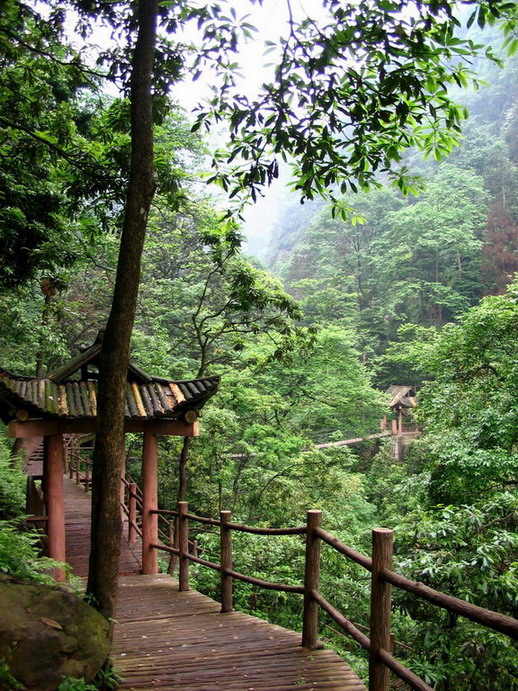 On Mount Emei, there are over 30 temples, ten of them large and very old; they are in local traditional style and most are built on hillsides, taking advantage of the terrain. In the selection of the site, design, and construction they are masterpieces of great originality and ingenuity. The advanced architectural and building techniques are the quintessence of Chinese temple architecture. Associated with these temples are found some of the most important cultural treasures of China, including the remarkable Leshan Giant Buddha carved in the 8th century CE out of the hillside of Xijuo Peak. Facing the confluence of the Minjiang, Dadu and Qingyi rivers, it is the tallest Buddha sculpture in the world with a height of 71 meters.
On Mount Emei, there are over 30 temples, ten of them large and very old; they are in local traditional style and most are built on hillsides, taking advantage of the terrain. In the selection of the site, design, and construction they are masterpieces of great originality and ingenuity. The advanced architectural and building techniques are the quintessence of Chinese temple architecture. Associated with these temples are found some of the most important cultural treasures of China, including the remarkable Leshan Giant Buddha carved in the 8th century CE out of the hillside of Xijuo Peak. Facing the confluence of the Minjiang, Dadu and Qingyi rivers, it is the tallest Buddha sculpture in the world with a height of 71 meters.
Criterion (vi)
On Mount Emei, the importance of the link between the tangible and intangible, the natural and the cultural, is uppermost. Mount Emei is a place of historical significance as one of the four holy lands of Chinese Buddhism. Buddhism was introduced into China in the 1st century CE via the Silk Road from India to Mount Emei, and it was on Mount Emei that the first Buddhist temple in China was built. The rich Buddhist cultural heritage of Mount Emei has a documented history of over 2,000 years, consisting of archaeological sites, important architecture, tombs, ritual spaces, and collections of cultural artefacts, including sculpture, stone inscriptions, calligraphy, painting, and music, among other traditional arts.
Criterion (x)
Mount Emei is a site of special significance to conservation and to science for its high floral diversity. The biodiversity of the site is exceptionally rich: some 3,200 plant species in 242 families have been recorded, of which 31 are under national protection and more than 100 species are endemic. This is due to its transitional location at the edge of the Sichuan basin and the eastern Himalayan highlands. Within its elevation range of 2,600 m are found a great variety of vegetation zones including subtropical evergreen broad-leaved forest, mixed evergreen and deciduous broad-leaved forest, mixed broad-leaved and conifer forests, and subalpine conifer forest. This exceptional flora is also rich in animal species with some 2,300 species recorded, including several threatened at a global scale.
Status
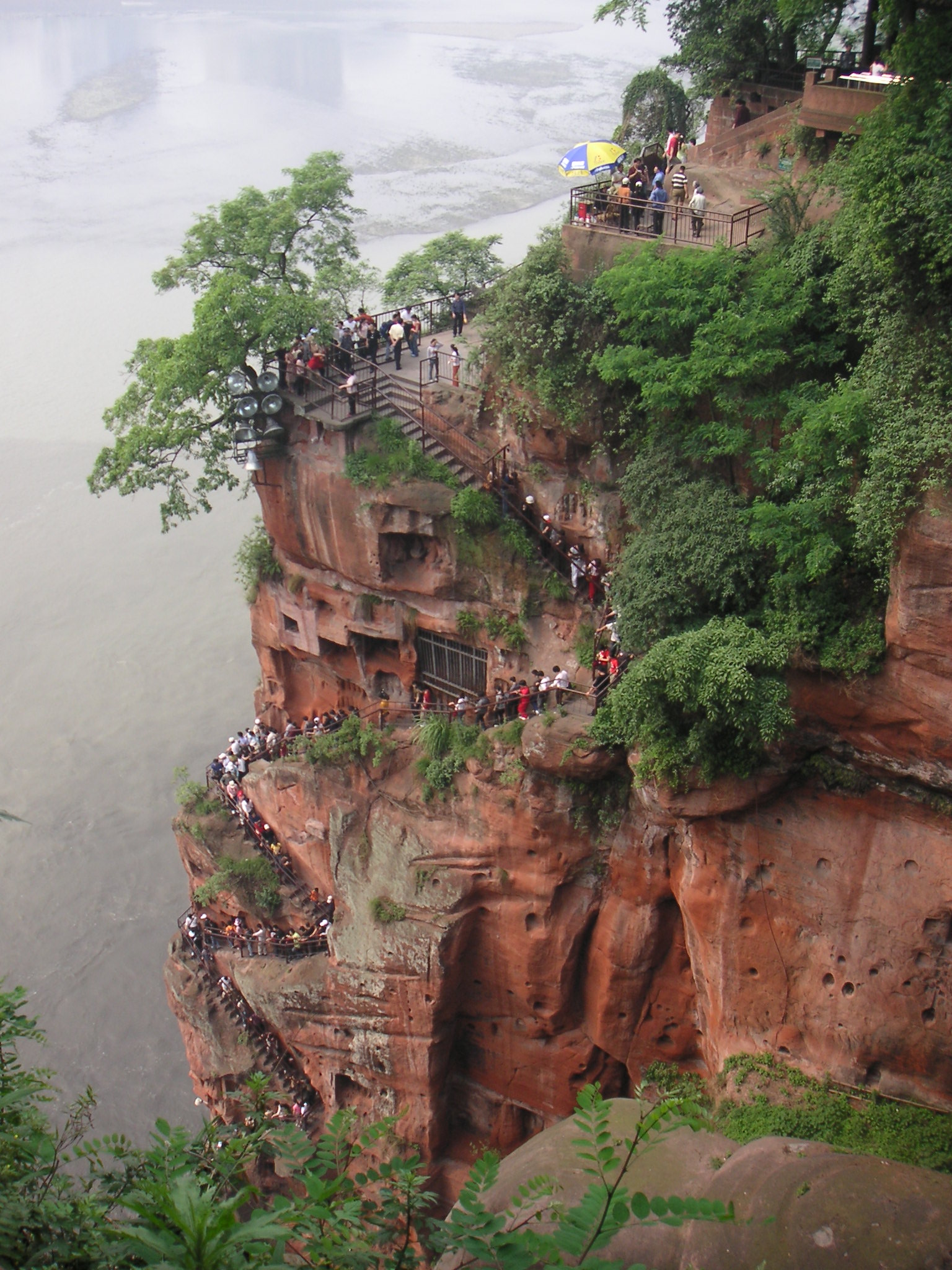 The initial plan for management and protection, the General Administrative Plan of Mount Emei, was unfolded in the 1980s. However, the site has been governed and maintained since the 10th century. In the present context, the protection plan follows the Central government’s Regulations on Scenery Areas, the provincial government’s Regulations on Scenery Areas, the provincial government’s Regulation on World Heritage Protection of Sichuan Province and the Regulations on Scenery Areas of Sichuan Province. The Management Committee of Mount Emei–Leshan Giant Buddha Scenic Area has enacted a blueprint for instituting 27 sectors to preserve the intrinsic beauty of the site. The sate party laid down an extensive set of policy frameworks for execution and conservation that were legally enforced by the Revised Master Plan for the Mount Emei Scenic Area and the Leshan Giant Plan Buddha Scenic Area. The heritage value is preserved so well that if any project has a detrimental impact on the heritage site, it is closely supervised after obtaining government approval. The Centre presents the monetary backing.
Construction for tourism activities has been increasing, especially around the Fuhu Temple. This has had repercussions on the sub-tropical broad-leaved forest of Mount Emei (IUCN Consultation 2017). Currently, the floods are damaging the site. The potential threats include water pollution, mainly caused by acid rain, which adversely impacts streams, rivers, ponds and lakes (Foster et al. 2010). Tourism is regarded as a critical source of funding, with the Scenic Spot Management Committee having raised approximately 2 billion yuan for shifting the local population from the scenic spot down to the mountain eventually.
Similarly, several measures are being carried out by the state party to consistently train and manage researchers to initiate protection of the property (IUCN Consultation 2020). The Mount Emei Museum educates visitors about the enshrined values of the site. Increased tourism, infrastructure construction and catastrophic events have resulted in a loss in plant diversity (Yao et al. 2018). The flood that took place on 19 August 2020 led to extreme water levels and thus could have led to destruction of the cultural and aesthetic values of the site. The toes of the Leshan Buddha were swept away by the floods. Because of such events, there was a strong response from Sichuan Province when many days of heavy rains led to extreme water levels. Flood alerts were issued to minimize the threat (BBC, 2020). The local authority administers the site with an effective management plan (People’s Republic of China, 1995;WCMC, 2012).
The main threats to Mount Emei include tourism, cable cars, construction activities, pollution, flooding, the legal framework and the enforcement measures. The pathway leading to the Golden Summit has been intruded by a cable car that carries 300,000 people each year to the sensitive Montane Forest Zone. A light monorail has also been constructed (1998) after the inscription of the property (ICOMOS 1995; IUCN 1995; SOC Report 2000) The predicament disruption associated with the monorail has remained minimal, and talks have been initiated on building a new cable car to Wanfoding Summit. However, the potential impacts of this development remain unclear. A long-term strategic plan can tackle the increasing numbers of visitors. The tourism operations have severely affected the biodiversity and soil quality. However, the local protection, coupled with the consistent management, has become more effective (Lu 2013; Zhu 2013; Fan 2012; IUCN Consultation 2017).
Construction for tourism activities has been increasing, especially around the Fuhu Temple. This has had repercussions on the sub-tropical broad-leaved forest of Mount Emei (IUCN Consultation 2017). Currently, the floods are damaging the site. The potential threats include water pollution, mainly caused by acid rain, which adversely impacts streams, rivers, ponds and lakes (Foster et al. 2010). Tourism is regarded as a critical source of funding, with the Scenic Spot Management Committee having raised approximately 2 billion yuan for shifting the local population from the scenic spot down to the mountain eventually.
Similarly, several measures are being carried out by the state party to consistently train and manage researchers to initiate protection of the property (IUCN Consultation 2020). The Mount Emei Museum educates visitors about the enshrined values of the site. Increased tourism, infrastructure construction and catastrophic events have resulted in a loss in plant diversity (Yao et al. 2018). It is crucial to note that though the management activities are effective, they need to be improved for certain plant and animal species to survive (Foster et al. 2010; IUCN 1995; UNESCO 2000).
The flood that took place on 19 August 2020 led to extreme water levels and thus could have led to destruction of the cultural and aesthetic values of the site. The toes of the Leshan Buddha were swept away by the floods. Because of such events, there was a strong response from Sichuan Province when many days of heavy rains led to extreme water levels. Flood alerts were issued to minimize the threat (BBC, 2020). The local authority administers the site with an effective management plan (People’s Republic of China, 1995; WCMC, 2012).
The initial plan for management and protection, the General Administrative Plan of Mount Emei, was unfolded in the 1980s. However, the site has been governed and maintained since the 10th century. In the present context, the protection plan follows the Central government’s Regulations on Scenery Areas, the provincial government’s Regulations on Scenery Areas, the provincial government’s Regulation on World Heritage Protection of Sichuan Province and the Regulations on Scenery Areas of Sichuan Province. The Management Committee of Mount Emei–Leshan Giant Buddha Scenic Area has enacted a blueprint for instituting 27 sectors to preserve the intrinsic beauty of the site. The sate party laid down an extensive set of policy frameworks for execution and conservation that were legally enforced by the Revised Master Plan for the Mount Emei Scenic Area and the Leshan Giant Plan Buddha Scenic Area. The heritage value is preserved so well that if any project has a detrimental impact on the heritage site, it is closely supervised after obtaining government approval. The Centre presents the monetary backing.
Construction for tourism activities has been increasing, especially around the Fuhu Temple. This has had repercussions on the sub-tropical broad-leaved forest of Mount Emei (IUCN Consultation 2017). Currently, the floods are damaging the site. The potential threats include water pollution, mainly caused by acid rain, which adversely impacts streams, rivers, ponds and lakes (Foster et al. 2010). Tourism is regarded as a critical source of funding, with the Scenic Spot Management Committee having raised approximately 2 billion yuan for shifting the local population from the scenic spot down to the mountain eventually.
Similarly, several measures are being carried out by the state party to consistently train and manage researchers to initiate protection of the property (IUCN Consultation 2020). The Mount Emei Museum educates visitors about the enshrined values of the site. Increased tourism, infrastructure construction and catastrophic events have resulted in a loss in plant diversity (Yao et al. 2018). The flood that took place on 19 August 2020 led to extreme water levels and thus could have led to destruction of the cultural and aesthetic values of the site. The toes of the Leshan Buddha were swept away by the floods. Because of such events, there was a strong response from Sichuan Province when many days of heavy rains led to extreme water levels. Flood alerts were issued to minimize the threat (BBC, 2020). The local authority administers the site with an effective management plan (People’s Republic of China, 1995;WCMC, 2012).
The main threats to Mount Emei include tourism, cable cars, construction activities, pollution, flooding, the legal framework and the enforcement measures. The pathway leading to the Golden Summit has been intruded by a cable car that carries 300,000 people each year to the sensitive Montane Forest Zone. A light monorail has also been constructed (1998) after the inscription of the property (ICOMOS 1995; IUCN 1995; SOC Report 2000) The predicament disruption associated with the monorail has remained minimal, and talks have been initiated on building a new cable car to Wanfoding Summit. However, the potential impacts of this development remain unclear. A long-term strategic plan can tackle the increasing numbers of visitors. The tourism operations have severely affected the biodiversity and soil quality. However, the local protection, coupled with the consistent management, has become more effective (Lu 2013; Zhu 2013; Fan 2012; IUCN Consultation 2017).
Construction for tourism activities has been increasing, especially around the Fuhu Temple. This has had repercussions on the sub-tropical broad-leaved forest of Mount Emei (IUCN Consultation 2017). Currently, the floods are damaging the site. The potential threats include water pollution, mainly caused by acid rain, which adversely impacts streams, rivers, ponds and lakes (Foster et al. 2010). Tourism is regarded as a critical source of funding, with the Scenic Spot Management Committee having raised approximately 2 billion yuan for shifting the local population from the scenic spot down to the mountain eventually.
Similarly, several measures are being carried out by the state party to consistently train and manage researchers to initiate protection of the property (IUCN Consultation 2020). The Mount Emei Museum educates visitors about the enshrined values of the site. Increased tourism, infrastructure construction and catastrophic events have resulted in a loss in plant diversity (Yao et al. 2018). It is crucial to note that though the management activities are effective, they need to be improved for certain plant and animal species to survive (Foster et al. 2010; IUCN 1995; UNESCO 2000).
The flood that took place on 19 August 2020 led to extreme water levels and thus could have led to destruction of the cultural and aesthetic values of the site. The toes of the Leshan Buddha were swept away by the floods. Because of such events, there was a strong response from Sichuan Province when many days of heavy rains led to extreme water levels. Flood alerts were issued to minimize the threat (BBC, 2020). The local authority administers the site with an effective management plan (People’s Republic of China, 1995; WCMC, 2012).
